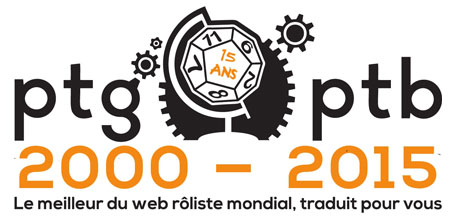
IN THE SHADOW OF THE SPIRE
SESSION 5: THE TROUBLE WITH GOBLINS
April 15th, 2007
The 19th Day of Amseyl in the 790th Year of the Seyrunian Dynasty
Tellith pointed to a man wearing a green shirt who was sitting dejectedly at one of the tables. In truth, there weren’t many others in the common room – although the bard for the night was strumming idly in one corner.
Ranthir was tired, however, and headed upstairs for some food and a good book. Agnarr spotted Cardalian (the woman he had spoken with at breakfast a few days earlier sitting in the corner) – he headed over to her and offered to buy them both dinner.
Tee, Dominic, and Elestra, however, went to go talk to the man, who identified himself as Eral Yinnick. It quickly became apparent that Eral was emotionally distraught: His son had disappeared earlier that day. He and his wife were convinced that the boy had been kidnapped by the “ghost of Greyson House”. They had told him and told him not to play near that house, but the boy seemed fascinated by it despite their sternest warnings.
“Why come to us?” Tee asked.
“Phon told me about you.” (“She did?” Tee said. “Maybe she’s warming back up to us,” Dominic suggested.) “She told me how you saved her. I went to the watch, but they wouldn’t help. I thought maybe… maybe you could do for Jasin what you had done for her. So I asked her where I could find her, and she said the Ghostly Minstrel. So I came here and I waited and…” He was babbling.
Tee, Dominic, and Elestra agreed that they should try to help if they could. Tee looked around and saw Agnarr heading back across the common room with two plates piled high with food. She suggested that Elestra should go see if Angarr wanted to help them, and she sent Dominic upstairs to check with Ranthir.
Elestra caught up with Agnarr just as he sat down to eat. She quickly outlined the situation to him. “Okay,” said Agnarr. “Just let me finish eating.”
“Finish eating? There’s a boy in trouble!”
“Fine, fine. Just give me five minutes! Just five minutes!”
Elestra turned to Cardalian. “You look pretty tough. You want to tag along?”
Cardalian shook her head and demurred. “No, I’ve been fighting rats all day. I’m exhausted.”
Agnarr paused from shoveling food into his mouth and looked over at Cardalian. “Rats? Really? You’ll have to tell me about that.”
Cardalian raised her eyebrow, “Aren’t you supposed to be eating?”
Meanwhile, Ranthir – with his food freshly laid out and his book freshly cracked – heard Dominic’s knock at his door. “Come in.”
Dominic quickly outlined the situation. “Come on, you can bring your food with you.”
“But… it’s soup!”
Ranthir forlornly put it aside, gathered his things and headed for the door.
Five minutes later, everyone was gathered with Eral in the lobby of the Ghostly Minstrel.
THE HAUNTING OF GREYSON HOUSE
The group headed up the hill towards the North Market. (“Wait, are we going up the hill to the haunted house? Or are we headed to the house on haunted hill?”) They discovered that Eral’s home – and Greyson House just across the street – were both located on Catbird Street, literally just around the corner from Phon’s house.
Agnarr realized that he now knew where Phon lived. Tee groaned at the thought of it, but she would have been even more worried if she had overheard Agnarr trying to “subtly” pump Eral for information regarding the father of Phon’s child on the way over. (Eral didn’t know anything.)
When they arrived, Eral quickly introduced them to his wife Ortesia – a woman completely overcome by her panic. They kept it short and immediately headed across the street.
(As they went, Agnarr remarked, “Hey, what are we getting paid for this?” He was met with blank states all around, and after a moment he said: “Oh. Got it.”)
Agnarr strode up onto the porch and tried the door handle. It was locked. But as Agnarr stepped back, the door began to rattle and shake and a low, mournful howl could be heard through the door.
Agnarr cocked his head to the side for a moment in contemplation, grunted, and then kicked the door open. A fetid mass of excrement, turpentine, and other foulness fell from above the door. The stench was nearly overpowering to Agnarr and Dominic (who stood just behind him), but they both steeled their stomachs against the nauseating stench.
Even as they paused to consider this sickening mess, a ghostly specter slipped out of the shadows and a hideous whisper seemed to echo through the house: “None shall live who enter this place…”
The spirit, however, had not considered the lust for battle which had been growing in Agnarr’s heart as a result of two days spent pent-up in a library and asking fruitless question. The barbarian rushed into the room, and although the ghost rushed forward to meet him, hot thews forged in the cold climes of the northern wastes proved the faster: The barbarian’s sword, flaming at his command – “For the glory!” – swept through the specter with a single sweep…
… revealing it to be nothing more than a sheet.
The sheet, reduced to a smoldering rag, fell to the floor. But what it revealed was perhaps even worse: A blood-sucking stirge, just like the ones that had nearly brought Tee and Agnarr to their ruin in the dark caves of the black reptilians. Agnarr cried out: “There’s a stirge in here, Tee!” And Tee, in panic, shouted back, “Kill it! Kill it! Kill it!”
Agnarr ducked as the stirge swooped down at him… which proved fortuitous, for at almost the same moment a small, runty goblin stepped out of the shadows in the same corner of the room from which the “ghost” had emerged and hurled a javelin at him! Both the stirge and the javelin passed harmlessly over Agnarr’s head.
Meanwhile Tee drew her longsword and rushed forward past her other companions, who were still somewhat uncertain what was actually happening. (“What the hell is a stirge?” Elestra asked, prompting Ranthir to happily elucidate her: “It’s a small, bat-like predator. Almost an overgrown mosquito, really. It feeds on its victims by plunging its proboscis into the soft flesh…”)
Tee, arriving inside the house, ducked past Agnarr and took a swing at the nasty little creature as it swooped over Agnarr’s head. She connected solidly, ripping one of its four wings completely off its body. Spurting blood, the creature attempted to attack Agnarr again, but the barbarian easily smote it to the ground in smoking ruin.
Elestra meanwhile, ignoring Ranthir’s recitation, moved into the house herself. The goblin, screaming unintelligibly in its native tongue, took a swipe at Agnarr and tried to run for the stairs. This proved to be its undoing: Elestra took it high and Agnarr took it low. The goblin’s head, torso, and legs fell in four distinct piles on the floor.
After the flurry of action, Elestra was shocked. All she could do was stare at her sword, which had seemed to dance of its own accord. The lethal, almost bloodthirsty instincts which were driving her were so strange… and yet they seemed so natural.
Tee, meanwhile, quickly took charge. “I think it was calling for help.” She set Agnarr to watch the stairs leading up to the second floor and she set Elestra to watch the only other door leading out of the room. Then she set about doing a quick search of the room, focusing particularly on the corner where the “ghost” and goblin had emerged from.
Ranthir and Dominic, meanwhile, wandered into the house as well. Ranthir, for his part, prodded the smoldering remains of the stirge: “Yes, indeed, this is a stirge. Well spotted, Master Agnarr…” Dominic, for his part, noticed that the commotion was already beginning to attract the attention of people up and down this quiet side-street. He turned and shouted, “Emergency exorcism! Nothing to be worried about!” He made sure to close the door behind him.
Tee found that the various debris and broken furniture in this room had been cunningly piled to conceal a hidey-hole of sorts in the corner of the room. It seemed likely that the goblin and the ghost-turned-stirge had hidden in this nook before emerging.
Tee then turned her attention to the door. She found it unlocked and untrapped (unlike the front door) and opened it, revealing the ruined remnants of a kitchen. In addition to a variety of trash, the rusted remains of an iron stove squatted in the corner. A trapdoor was clearly evident in one corner of the room.
Tee crossed the room and flipped open the trapdoor. She saw a ladder leading down into darkness – probably a cellar of some sort. Looking around she spotted bones scattered here and there throughout the rubbish – bones which Ranthir thought mainly belonged to small animals, although a few very old human bones were also to be found.
The group decided that it would be better to check the upstairs first before venturing down the ladder: The goblin had been trying to escape in that direction, after all. Leaving Ranthir and Dominic to guard the trapdoor, Tee, Elestra, and Agnarr headed up the stairs (with the barbarian in the lead). Ranthir nervously closed the trapdoor with his toe.
They didn’t find much of anything up there. At the top of the stairs there was an essentially barren room. Through a door they found a bedroom with a four-poster bed fallen into rotten ruin. Off the bedroom they found a closet which, judging by the smell and the piles of waste and excrement, had apparently been seeing use most recently as a toilet.
As Tee began thoroughly going over the upstairs rooms to make sure nothing had been missed, however, the trapdoor downstairs suddenly burst open and a goblin scurried out. Ranthir and Dominic were caught by surprise, allowing a second goblin to scurry out of the hole before they could react.
Dominic called out for help from upstairs, stepped forward, and began beating the first goblin with his mace – slamming it up against the wall with the satisfying crunch of broken ribs.
Tee, Elestra, and Agnarr raced downstairs. On her way, though, Tee noticed someone peering through the grime-covered front window. She hurriedly opened the front door and stepped out to discover that a relatively large crowd of people had gathered in front of the porch, and one of these on-lookers had become overly eager and was up on the porch trying to get inside. He jumped as Tee came out. “Oh! Hey there! What’s going on in there?”
“Emergency exorcism,” Tee said. “You should step back. You don’t want to be hurt.”
“But it sure sounds like something interesting is going in there! I just want to—“
Tee bared a quarter inch of steel. The man blanched. “Ah, right. Of course. I’ll just be backing away to a safe distance then. Good point.”
Tee ran back in, making sure to close the door behind her. “Sorry I’m late. Had a bad case of nosy neighbors.”
With everyone crowded into the kitchen and weapons swinging wildly, it was a cramped fit… which only seemed to help the party rapidly overwhelm both goblins.
But Dominic said that he had seen a third goblin crawling up out of the basement – a goblin who had disappeared back into the darkness when he’d seen how badly things were going for the other two. So Agnarr quickly jumped onto the ladder and started climbing down…
…but the ladder broke under his weight! (“You just had to finish eating dinner, didn’t you!” Tee called after him.) Agnarr tumbled in a painful heap on the hard stone floor of the cellar ten feet below. And, as he picked himself up, three goblins popped up from behind some crates and hurled javelins at him!
Agnarr growled deep in his throat, plucked one of the javelins from where it had lodged in his shoulder, drew his greatsword, and charged. Unfortunately it proved hard to bring his weapon to bear on the goblins, which were darting here and there behind the haphazard crates.
Ranthir scrabbled at his pack… only to find that he’d left his rope stored back at the inn! Tee pushed him out of the way, pulled out her own rope and grappling hook, and quickly secured them to the iron stove.
Even as she was finishing the knots, Elestra grabbed the rope and hurriedly dropped into the basement. She, too, charged the goblins and felt her rapier dancing in her hand…
But at just that moment, Agnarr – finally fed up with the scurrying little runts – grabbed one of the crates and hurled it to one side. This left his own swing open to gut one of the goblins, but the crate hurtled straight into Elestra’s sword and knocked her blow aside.
Tee quickly rappelled down the rope herself, landing lithely at the bottom and taking stock of what was happening. She drew her sword…
…just in time for Dominic, who had failed to get a firm grip on the rope, to fall right on top of her. Both of them fell prone just as the door on the south side of the cellar flew open and three more goblins came rushing out!
Elestra, finding herself suddenly surrounded, quickly circled around behind the goblin she was fighting, although she took a nasty blow in the process. Tee tried to scramble to her feet, but received a nasty mace blow across the top of her head which left her dazed and reeling. Dominic scrambled to his feet, as well, but found himself directly in Agnarr’s way – stopping the raging barbarian from reaching the goblins who had just arrived.
Chaos reigned for a moment, but it didn’t take long for the group to turn things around. Goblins fell left and right until, finally, the last goblin – hissing a snarl that revealed its fang-like teeth – slammed the door.
The party took a moment to assess its wounds. Some of them were bloodied. Some of them were bruised. (Dominic took a moment to heal the particularly nasty wound on Agnarr’s shoulder.) But they felt they could continue. Agnarr kicked open the door through which the goblin had fled and found…
…nothing. A small room stacked high with rubbish. There were more bones here, as well, these considerably… juicier… than the ones in the kitchen above. But no doors. And no sign of the goblin.
Tee carefully moved into the room, looking for any sign of the missing goblin. Unfortunately what she found was Jasin’s body. The body had clearly been gnawed upon and several large cuts of meat had also been removed. Dominic quickly inspected the body, but it was so badly mutilated… Jasin had probably been dead before they ever spoke with Eral.
Tee gathered the body up in a spare cloak. As she was carrying it back out to be lifted through the trap door, she noticed a hole in the cellar wall which had been somewhat clumsily concealed by a stack of crates. A hurried discussion ensued, but the group agreed that they had accomplished what they’d come for: Recovering Jasin.
Tee emerged from the front door, carrying Jasin’s shrouded body in her arms. The crowd of onlookers began to murmur, and over their heads Tee could see Jasin’s mother, Ortesia, collapse on the porch of her own home. With bowed head she crossed the street and lay Jasin’s body down. “I am so sorry for your loss.”
“But there’s still a chance we could save him, isn’t there?” Elestra said, with a note of desperate hope in her voice. “He can’t have been dead for more than a few hours. He could be healed with magic.”
Eral shook his head and stammered. “We can’t afford anything like that.”
“And we don’t have the money either,” Agnarr said.
“So that’s it?” Elestra said. “We’ve got at least nineteen or twenty hours. Don’t we want to at least try something?”
“Like what?” Agnarr said. Then his eyes lit up and he turned to Tee, “We could sell your house!”
Tee stared at him blank-faced. She blinked once. “What?”
“We could sell your house! It’s the only thing of value that we have!”
“What ‘we’ are you talking about? It’s my house!” Tee shouted. She pulled herself under control long enough to offer condolences to the Yinnicks yet again and then strode off. After a moment the others followed. Dominic paused for a moment, “Someone should call the Watch. There may be more goblins in the basement.”
HEAVY HEARTS
With heavy hearts the group returned to the Ghostly Minstrel. Dirtied and bloodied, the group headed for the stairs, hoping to get cleaned up and find some much-needed rest.
As they reached the second floor, however, the group heard a strange and mournful song echoing through the halls. Rounding the corner they saw a spectral figure playing on a lute turning around the corner. Following it they came around the corner themselves just in time to see it walk through a wall.
Ranthir knocked on the door near where the ghostly figure had disappeared, but there was no answer. He frowned in thought, “Well, my curiousity has been piqued.”
Someone suggested that they might go downstairs and mention this to the owner. At the bottom of the stairs they saw that Tellith was still on duty at the front desk, approached here, and explained what had happened.
Tellith smiled. “Ah, you’ve seen the Minstrel have you? You’re fortunate ones. Most hear nothing more than his song, and they are lucky at that.”
Agnarr growled. “Of course. The whole place is called the Ghostly Minstrel!” He threw his hands up and headed up the stairs to bed.
Ranthir asked if they might be given access to the room the ghost had disappeared into. “Of course,” Tellith said. “As long as its not occupied. Which room was it?” When he described the location of the room, however, she shook her head. “Oh, I’m sorry. That’s Cardalian’s room. I can’t let you in there.”
“Do you know if Cardalian is in the inn tonight?”
Tellith shook her head. “I don’t think so. She left earlier this evening and I haven’t seen her come back.”
The group concluded that there wasn’t really anything else they could do about their sighting of the eponymous Ghostly Minstrel, so they broke up for the evening: Dominic and Ranthir followed Agnarr upstairs, but Tee and Elestra decided it was still too early in the evening for them. Tee decided to hit some of the legitimate gambling houses she had found out about and spent her time idly wagering various sums.
Elestra, on the other hand, stayed at the Ghostly Minstrel and hung out in the common room. Spotting Steron Vsool – the paladin she had spoken with a few nights earlier – sitting by himself, she wandered over and asked if she might join him. They chatted amiably for a few moments before Elestra steered the conversation towards recent events… particularly the riot.
Elestra dropped the suggestion that there might have been a bit more to the riot than just random circumstance and bad luck, and Steron picked it up and ran with it. “That’s exactly why they arrested Helmut Itlstein, or so I’ve heard,” he said. “And I’ve heard that there have been more arrests since last night.”
“Really?” Elestra said. “Who have they been arresting?”
“I don’t know. But if I had to place a wager, I’d say the Commissar is rounding up other Republican leaders. Probably because Helmut named names.”
“But why would the Republicans start a riot at their own event?” Elestra wondered out loud.
“Maybe they didn’t,” Steron said. “The Commissar may just be using that as an excuse to round them up. They’ve been a thorn in his political side for awhile now.”
At that moment, a large ogre with bluish skin and ioun stones swirling about his head, tapped Steron on the shoulder. “Steron, may I speak with you?”
“Of course, Urlenius,” Steron said. “If you’ll excuse me, Elestra?”
Steron left. Elestra got up as a well and was about to head up to bed when she spotted Iltumar Shon coming into the common room. She waved to him and he hurried over.
Iltumar had finally figured out the riddle she had apparently given him, “Is it a sawhorse, mistress Elestra?” She agreed that it must be and complimented him on his cleverness.
Iltumar gushed and was clearly trying to impress Elestra. Elestra, for her part, was patient and friendly. Eventually, though, she made her excuses and headed up to bed.
DORAEDIAN’S SUMMONS
Tee was awakened before the crack of dawn by a knocking on her door. Cracking it slightly she found a messenger waiting for her: “Mistress Tee? A letter for you.”
Looking at the letter she saw her name written in Doraedian’s familiar handwriting. Quickly ripping it open she found a very terse note:
Tee—
I have read your most recent letter. It is of the utmost importance that you come to see me with all due haste! It is urgent!
Doraedian
Tee immediately grabbed her things and headed up the hill to Iridithil’s Home. A false sunrise was cresting the ocean horizon and casting purple shadows across the face of the Spire. Iridithil’s Home itself was still in the cool, pre-dawn air – it seemed that almost no one was stirring, yet. Tee found Doraedian waiting for her in his office with the door open.
It turned out that, as Tee had suspected, Doraedian considered the reference Ranthir had found to a “city of dreams” to be incredibly important. He explained to Tee that the City of Dreams was spoken of in the Book of Secrets: It was an ancient elven city – a center of learning in which the legendary Elders of Dreaming would gather. But it was also said to have been lost in a great cataclysm. Indeed, the true lore of the City had been lost to them and only a handful of fragmentary references were left.
“I owe you an apology, Tee. You were right and I was wrong. The path that you are on seems inextricably bound to knowledge you do not have. It is time for you to learn the secret lore of the Dreaming. First I must consult with the other elders, but within a few days I will send you word of when your training is to begin.”
Tee was overjoyed, though she kept it as contained as she might. “Will I still be able to journey with my companions?”
“Yes,” Doraedian said. “Indeed, it is imperative that you do so. Your training will be carried out when it is possible for you to find time for it. But you must discover the purpose of the path that you walk.”
QUESTIONS AND A FRESH RESOLVE
(08/20/790)
The next morning the group met for breakfast, with Tee arriving first in the common room. It was a quiet and reserved meal, with very little being discussed.
Elestra eventually broke the ice by discussing what Steron had told her the night before. Agnarr thought, if all that was true, Phon might have been arrested: If Helmut wanted her out of the way and was naming names, he could have easily named her as well.
But after that momentary burst of information, the conversation remained sullen and uncertain. The death of Jasin was still heavily felt. Eventually someone broached the issue directly, and suggested that they should go back to that house, see what the Watch had done, and take whatever steps were necessary to permanently end the goblin threat there.
As if summoned by the mere mention of their name, two members of the Watch came through the front door of the Ghostly Minstrel. They looked around, spotted the group, and headed over.
“Are you Mistress Tee, Mistress Elestra, Master Agnarr, Master Ranthir, and Master Dominic? Please come with us. We have a few questions for you at the watchhouse.”
After confirming that they were not, in fact, under arrest, the group crossed Delver’s Square with them. It turned out that the Watch had a few questions regarding the “incident” at Greyson House the night before, but it seemed to be little more than a cursory follow-up. It quickly became apparent that, while they may have checked the house, they hadn’t found the secret passage in the cellar. They had posted a guard of some sort… but how long would they stay on duty there?
The group asked if they might be given permission to go back into the house and explore the secret passage they had discovered. The watchman shrugged. But when he learned they were members of the Delver’s Guild he agreed to ask his captain. He left, and when he returned he confirmed that they would be given unfettered access to the house.
They left the watchhouse and headed toward the North Market, their hearts perhaps a little lighter with their fresh-found purpose…



















